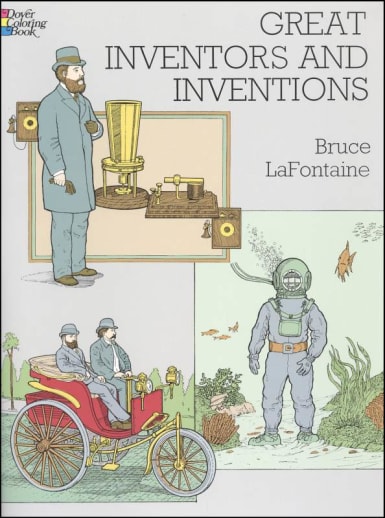Forty-five finely detailed drawings depict inventors and their important inventions - from Gutenberg's printing press with movable type (1438) and James Watt's steam engine (1763) to Jaques Cousteau's aqua lung for scuba divers (1942) and Hard Townes's laser (1964). Included also are excellent illustrations of David Bushnell's submarine, the "Turtle" (1776); Count Alessandro Volta's battery (1800); Robert Fulton's steamboat, the Clermont (1807); the telegraph, perfected by Samuel F.B. Morse (1837); the Lenoir Brothers' internal combustion engine (1860); the electric light bulb, developed by Thomas Edison and Joseph Swan (1878-79); Karl Benz's motorized wagon (1885) and many other notable advances. Explanatory captions provide background information on inventors and inventions, making this an educational and fact-filled guide. All this, and you can color it, too!
Great Inventors and Inventions Coloring Book
SKU
000452
ISBN
9780486297842
Grade 3-AD
These icons are designed to help you quickly understand and learn important information about our products.
Teaching Method
Traditional
Teacher-centered curriculum commonly used in classrooms that may include a text, teacher manual, tests, etc.
Charlotte Mason
A methodology based on the work of a 19th century educator who maintained that children learn best from literature (Living Books), not textbooks.
Classical
A methodology based on the Latin Trivium (three stages of learning), including the grammar stage (memorization and facts), logic stage (critical thinking), and rhetoric stage (developing/defending ideas).
Unit Study
A thematic or topical approach centered around one topic that integrates multiple subject areas.
Montessori (Discovery)
A methodology based on the work of a 20th century educator that emphasizes student and sensory-driven discovery learning and real-life applications.
Other
Other methodologies
Religious Content
Secular
Contains content contrary to common Christian beliefs (i.e. evolution).
Neutral
Avoids religious or theoretical topics or presents multiple viewpoints without preference.
Christian/Religious
Faith-based or including instructional religious content.
Learning Modality
Auditory
Learns through listening, talking out loud or reading out loud.
Visual
Learns through seeing, prefers written instructions and visual materials.
Kinesthetic/Tactile (Hands-On)
Learns through moving, doing and touching.
Multi-Sensory
Curriculum that employ a variety of activities/components.
Presentation
Sequential
Curriculum progresses through well-defined learning objectives. Emphasizes mastery before moving to the next topic.
Spiral
Topics and concepts are repeated from level to level, adding more depth at each pass and connecting with review.
Conceptual/Topical
Focus is on the “why,” often with a unifying concept as well as specific skills; coverage may be broader.
Teacher Involvement
Low Teacher Involvement
Student-led materials; parent acts as a facilitator.
Medium Teacher Involvement
A mix of teacher-led time and independent student work.
High Teacher Involvement
Teacher-led lessons; may utilize discussions, hands-on activities and working together.
Additional Materials Required
No other materials needed
Everything you need is included.
Other Materials Required
There are additional required resources that are a separate purchase.
Other Materials Optional
There are additional resources mentioned or recommended but are not absolutely necessary.
Consumable
Consumable
Designed to be written in; not reusable.
Non-Consumable
Not designed to be written in; reusable.
Our Price
$5.99 $5.99 $4.95
Rainbow Savings: $1.04
Description
Publisher's Description of Great Inventors and Inventions Coloring Book
From Johannes Gutenberg's fifteenth-century printing press to Charles Hard Townes' relatively recent development of the laser, this fascinating coloring book encompasses five centuries of technology. Forty-five finely detailed drawings depict inventors and their historically important devices, comprising an inspiring survey of advances in science and industry.
The excellent illustrations include James Watt's steam engine (1763), David Bushnell's submarine (1776), Count Alessandro Volta's battery (1800), and Samuel Morse's telegraph (1837). Among other featured innovations are Karl Benz's motorized wagon (1885), Thomas Edison's electric light bulb (1878-79), moving picture kinetoscope (1876) and phonograph (1895), Henry Ford's assembly line (1908), Jacques Cousteau's aqua lung for scuba divers (1942), and many more.
Informative captions provide background information about the inventors and their inventions, making this not only an entertaining volume for coloring book enthusiasts but also an educational and fact-filled guide to developments in the world of science and technology.
The excellent illustrations include James Watt's steam engine (1763), David Bushnell's submarine (1776), Count Alessandro Volta's battery (1800), and Samuel Morse's telegraph (1837). Among other featured innovations are Karl Benz's motorized wagon (1885), Thomas Edison's electric light bulb (1878-79), moving picture kinetoscope (1876) and phonograph (1895), Henry Ford's assembly line (1908), Jacques Cousteau's aqua lung for scuba divers (1942), and many more.
Informative captions provide background information about the inventors and their inventions, making this not only an entertaining volume for coloring book enthusiasts but also an educational and fact-filled guide to developments in the world of science and technology.
Category Description for History of Science / Scientific Discovery
Materials that cover scientific developments through history, famous scientists, inventors and inventions.
Details
| Product Format: | Softcover Book |
|---|---|
| Grades: | 3-AD |
| Brand: | Dover Publications |
| Author: | Bruce Lafontaine |
| ISBN: | 9780486297842 |
| EAN/UPC: | 800759297849 |
| Length in Inches: | 11 |
| Width in Inches: | 8.25 |
| Height in Inches: | 0.25 |
| Weight in Pounds: | 0.4 |
| Edition: | Illustrated |
| Pages: | 48 |
Videos
Reviews

